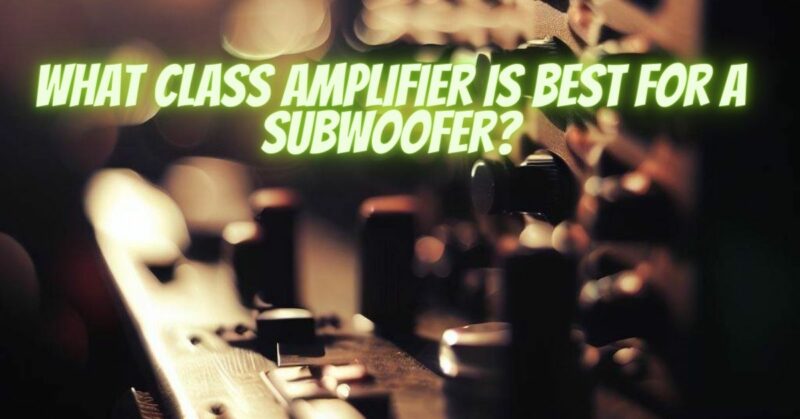Subwoofers play a crucial role in enhancing the audio experience, adding depth and impact to music, movies, and other multimedia content. To fully unleash the potential of a subwoofer, selecting the right amplifier class is essential. In this article, we will explore the various amplifier classes and help you determine which one is best suited for powering your subwoofer.
Understanding Different Amplifier Classes:
Before diving into the best amplifier class for a subwoofer, let’s briefly review the characteristics of the most common amplifier classes used in audio applications:
1. Class A Amplifiers: Class A amplifiers provide a continuous current to the output transistors, resulting in high linearity and audio fidelity. However, they are inefficient and generate significant heat, making them less practical for powering subwoofers, especially in high-power applications.
2. Class AB Amplifiers: Class AB amplifiers are a popular choice for many audio systems. They combine the efficiency of Class B amplifiers with the linearity of Class A amplifiers. Class AB amplifiers draw less current at low-level signals, which improves efficiency compared to Class A, but switch to Class B operation at higher signal levels to handle increased power requirements.
3. Class D Amplifiers: Class D amplifiers, also known as digital amplifiers, use pulse-width modulation (PWM) to amplify the audio signal. They are highly efficient and generate less heat, making them suitable for high-power applications. Modern Class D amplifiers have made significant advancements, delivering excellent sound quality and reliability.
Best Amplifier Class for Subwoofers:
Class D Amplifiers:
When it comes to powering subwoofers, Class D amplifiers have become the preferred choice for several reasons:
- Efficiency: Class D amplifiers are significantly more efficient than Class A and Class AB amplifiers. They waste less power as heat, leading to higher energy efficiency and reduced operating costs.
- High Power Handling: Subwoofers often require substantial power to reproduce low-frequency sounds accurately. Class D amplifiers can deliver the high power needed for impactful bass without excessive heat generation.
- Compact Size: Class D amplifiers’ efficiency allows them to be designed in a compact form factor, making them suitable for integration into space-constrained subwoofer enclosures or installations.
- Less Heat Dissipation: The reduced heat generation of Class D amplifiers contributes to their reliability and prolongs the lifespan of subwoofer components.
- Excellent Sound Quality: Advancements in Class D amplifier technology have led to improvements in sound quality. Many modern Class D amplifiers offer audiophile-grade performance with low distortion and accurate bass reproduction.
Considerations for Subwoofer Amplifiers:
While Class D amplifiers are an excellent choice for subwoofers, there are some essential considerations:
- Power Rating: Ensure that the Class D amplifier has sufficient power output to match the subwoofer’s power handling capabilities. Underpowering or overpowering a subwoofer can lead to distorted sound or potential damage.
- Frequency Response: Check the frequency response range of the amplifier to ensure it matches the subwoofer’s capabilities. Subwoofers typically handle frequencies in the low-end range, so the amplifier should be able to deliver power in that range effectively.
- Crossover and Phase Settings: Many Class D amplifiers for subwoofers come with adjustable crossover and phase settings, allowing you to fine-tune the subwoofer’s integration with the main speakers for seamless bass reproduction.
For powering subwoofers, Class D amplifiers emerge as the top choice due to their efficiency, high power handling capabilities, and compact size. They deliver impactful bass with excellent sound quality while minimizing heat generation and operating costs. When selecting a Class D amplifier for your subwoofer, consider the power rating, frequency response, and additional features that will optimize its performance and integration within your audio system. With the right Class D amplifier driving your subwoofer, you can immerse yourself in a world of rich and powerful low-frequency sound that elevates your audio experiences to new heights.


